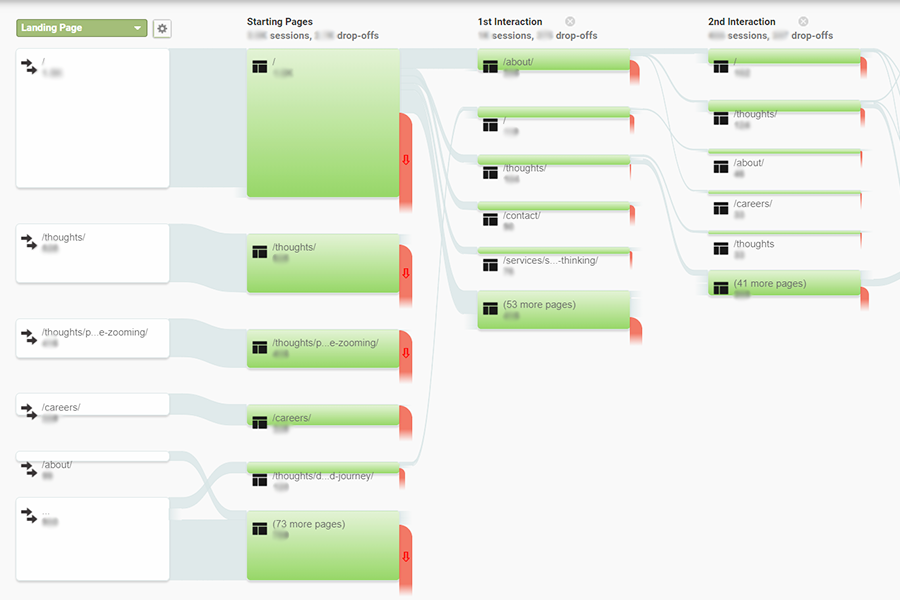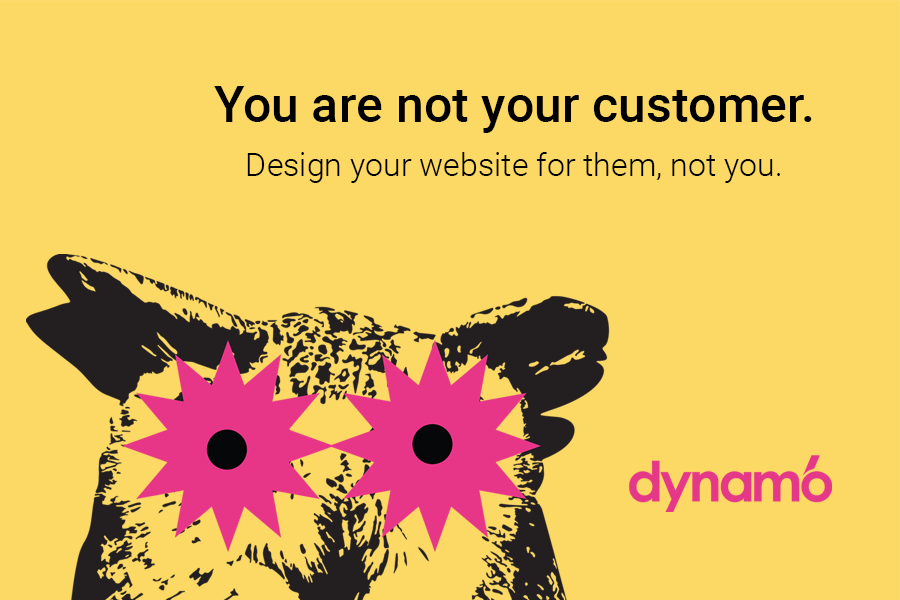Startyournewwebsitedevelopmenttherightway
A website is an important part of leading potential customers to your products and services, an interface for customers transacting with you, and one of the best ways to get your brand into the world.
Website design and development is an investment
Whatever your website is used for, I think it’s fair to say your website is a big deal for your business. So it’s important to think and plan carefully when you begin an investment in upgrading or completely redesigning your website.
When a new website is designed and developed in the right way, it will turn your web traffic into quantifiable conversions. If it’s not done in the right way, that doesn’t function or has lost the creative vision, you could find yourself in a vicious cycle of fixes and changes or simply dealing with a lame-duck website that never performs properly.
So kick off that new website development project on the right foot. Here’s our non-exhaustive list of things to think and do as you’re starting off.
Practicing what we preach
We’ve recently redesigned and redeveloped our website. Developing websites is also our bread and butter, so we wanted to share some points you need to ponder before jumping into a website development project.
Learn from the old dog before you get some new tricks
While you might be more than ready to see the back of your current website, don’t move too fast! There are likely a lot of things you can learn from it first. Taking the time to find out how your website is meeting and failing your digital goals will give you a wealth of information on what you should and shouldn’t be doing on your new website.
Answer the 5 Ws
If you want your next website to be better, to deliver higher ROI, and to target your customer base better, then you need to be very specific about what you want your new website to achieve and why. Ask yourself:
- Why am I replacing my website?
- What does and what doesn’t work for users on my website?
- Who visits my website? And, are they my customers?
- When do people visit my website?
- What are people trying to achieve when they are on my website?
If you’re having trouble answering any of these questions then you’re simply not ready to move into new website development. It’s important to be able to answer these questions with quantifiable data to determine what your new website should do and what your success looks like.
Understand your current users’ behaviour
The insights that you generate from your analytics tools, such as Google Analytics and HotJar, can give you a good understanding of what works well in your current website and what doesn’t.
Other user experience techniques could also be considered, such as usability testing, and user research.
Google Analytics
Your website analytics is a great source of what does and doesn’t work on your website. The reports that we found really useful for understanding our website were:
- Website flow
- Entry pages
- Device and browser report
The browser report, for example, showed us that most of our web visitors use Chrome and use the last 2 versions. We had a discussion about which browsers our website supports and using this report showed us that we didn’t need to support Internet Explorer browsers. A decision our developers heartily endorsed.
The ‘User Flow’ report can show you the most visited web pages and where users go to from the page. If you see a high exit rate on pages that aren’t a completed goal, that may signify that you need to work on how to keep your website visitors on your website.
The website flow and entry pages informed us what content our website visitors like to see. Using this insight can inform you on how you should structure your website’s content and navigation menu to meet your users’ needs.

The image above shows Dynamo6’s user flow report in Google Analytics for the previous version of our website.
Usability testing
Getting a user experience specialist to design tests that are put in front of typical users to complete can yield very important information on where your current website does and doesn’t get it right.
For some reason, this is an oft-overlooked area of investigation, but if it’s done right can allow you to hone in on specific areas that trip up or disengage users. I’ve found that it’s often surprising for our customers how little a user will understand and absorb while navigating to an end goal and can really highlight the need for careful user journey design.
Take the good with the bad
Putting those traffic behaviours and research data insights in front of your development team will mean they can help you work to the strengths of your previous website and avoid the issues of the past.
Out with the old, in with the new
Now that you’ve understood how your current website performs, it’s time to start planning for the new one. So start planning in the right place. Often people will go straight into visual requirements like “fresh, clean, good use of white space, the buttons have to pop”, and on and on. Apart from being vague and clichéd, it’s not the place to start.
Or they might start by saying that they have to increase their website visits. This is getting closer to being right, but you need to remember that...
Website visits just aren’t that important
Visitors are wonderful when you’re having a BBQ, but they are not something you should place too much emphasis on for your website. What is far more important is converting the visitors you do get into actions that matter to your organisation.
Usually, visitors are either trying to get something done, that’s their goal. Your objective is to make your website visitors’ goals as easy as possible to achieve. These are the important things.
Define your goals
So instead you need to be very clear about what these activities are - the goals of your website. Then you can make sure your website is designed in a way to facilitate these activities and then track the performance of those activities instead. Website visitors just become a funnel for increasing the performance of your goals.
There may be a few goals that you want your web visitors to accomplish. Some examples of goals could be:
- Viewing opening hours
- Checking event information
- Registering for a webinar
- Signing up for a newsletter
- Completing a contact us form
- Creating an account
- Purchasing a product
- Completing a service request form
Your website is not for you
As you begin planning your new website build, be careful who you give the responsibility of making decisions about how this website will look and behave. You might be paying for it, but that doesn’t mean you should get to dictate requirements. Your website is for your customers, pure and simple. If it doesn’t work for them, it doesn’t work. Regardless of how amazing you think it is.
Realising this means that you need to very clearly understand your customers and their needs to ensure you have a successful website. In fact, their needs should define what “successful” means. Making decisions about your website with your key visitors in mind ensures you are building something that they will like. This is most likely to get results which you, in turn, will like. The detail of building out the purpose of the site and the various customer journeys and goals it needs is a blog topic in itself.

A D6 motto: “You are not your customer. Design your website for them, not you.”
With this in mind, designate a “Product Owner” for the website who will lead and make key decisions during the project. Their responsibility is to know the customer intimately and translate that, with the help of the development team, into a website that will operate perfectly for what your customers need. You can give them constraints to work to - time, budget, etc. But leave it to them to decide how to deliver on that. The biggest job for you is choosing the right person.
Of course, it’s important to have accountability on projects in your organisation. Just be careful who gets to make the decisions that affect the people visiting the website. Being empowered to bring a strong vision to life can produce great results. It just also involves lots of trust.
Its all about the journey
I’ve already mentioned user journey development a little bit. This is the point where you actually start building them out. Since you now have clear goals and understand your users very well, you’re in a good place to build out those journeys.
Get a user experience expert to develop these user journeys out with you. Make sure your user research is robust enough to not have to guess, and test them with real people before you lock them in place. I’ve sometimes heard people complain about spending time here playing with different ideas. But trust me, it’s far cheaper to change now when it’s just a piece of paper or a quick interactive screen than when it’s a fully developed and integrated website.
Writing content is not for the faint-hearted
What is a website if not a platform for your message? Whether that message is “buy an awesome electric skateboard” or “trust our team to take care of your taxes” clarity around your content drives the best design and development outcomes.
Your website is not a report, white paper, essay, proposal, novel or newspaper. It doesn’t need to contain every detail, it just needs to guide visitors to take the desired action.
Content first, then design
So many web projects have made the mistake of getting into the design work before having completed the content. And so many projects start all of that without understanding the user experience.
Once you have a good handle on your visitors and the customer journeys and goals they need to accomplish, content creation comes next. Storyboarding your content through the customer journeys will ensure a logical flow to make sure people get all the information they need to help complete their goals.
Once your page content is completed and nicely aligned with what you know about your website visitors, then it’s time to start making it pretty.

Don’t get yourself in a writing jam. Get a professional copywriter.
Write and design for scanning
People are not going to read the content on your website as much as they will scan it. Search engines will do the same. Your content has to be created to please them both. This is not easy. If at all possible, use a professional web copywriter.
Keep it fresh
While we’re on the topic, the web gods (aka Google) love an updated website. Ensure you have a plan for regular content updates on your website. A blog or news area are common ways of doing this. Most sites are designed so you can edit the key content yourself, rather than paying a developer for content changes. Equally as important as new content, is making sure you keep your business hours, locations, and services up to date as they evolve.
Selecting a CMS
This is another topic that needs to be a blog in its own right. Here are some quick pointers that you may not have thought about before when selecting a CMS.
Ubiquity
The more niche the platform, the less choice you have about who can build it and maintain it. Some agencies will work with a platform so niche that only they or a small handful of other companies work with it. Great for them to lock you into their service. Not great for you if you need to look for a new agency to support the system.
At the other end of the scale, some platforms suffer from being too ubiquitous. For example, WordPress supposedly powers 43% of the internet* so is by far the most used. But because WordPress is so highly used, its weaknesses are also well known. A WordPress implementation can be done very badly giving poor performance, security, reliability and usability. Not necessarily the fault of WordPress — it’s just a victim of its own success!
* Source: WordPress.Org
Specific features
It’s important to work through the requirements for what you need out of the CMS. While most platforms will have a reasonably common set of features, others will focus on particular areas. Some have a more marketing automation focus, or a blogging focus, or the ability to build out custom functionality.
Don't get blinded by slick marketing videos or cool widgets - start with what you need and see where that leads.
Ease of use
Frustratingly I’ve seen a pattern where ease of use is directly proportional to the power of the feature set of a CMS. Some amazingly powerful CMS platforms are borderline unusable, whereas beautifully designed CMS platforms hardly do anything. My suggestion is to try before you buy if you’re not already familiar with the platform and make sure it’s something your team can work with.
Team maturity
This is something that always seems to be overlooked, but it can be a big issue with spending money on features that end up not being used. Take a reality check to see if you’re stretching your team with automated marketing workflows, campaign landing page management, online customer tools, etc. If your team isn’t ready, then your shiny new CMS feature set just won’t be used. Match the CMS to where your team is at.
Website hosting is not boring
Hosting is one of the most important and often overlooked parts of a website. It seems often that the decision to host a website is made for the customer by the development team. But infrastructure is a fundamentally different discipline that shouldn’t be overlooked.
Dynamo6 is a little unique in that we work across both infrastructure and development, so we have specialists in both areas. So our hosting platform is world-class. Most organisations work in either one or another discipline. If you’re working with a development-only company it’s probably a good idea to find a separate hosting provider.
Host in the cloud
Some hosting is still offered by companies running their own servers in a data centre somewhere. But in this day and age, you shouldn’t be hosting a website on anything other than public cloud services. Having your website sitting on a server in Auckland just won’t beat the performance you’d see by having it hosted in Amazon Web Services or Google Cloud Platform. Autoscaling means you can keep a lean server setup that grows as demand increases.
Think about more than uptime, redundancy and speed. Having hosting integrated well into your development process through CI/CD decreases the cost of deploying updates and gets them out faster.
Keep secure with updates
Finally, security has to be top of mind for your website. A hosting provider needs to be hardening their servers to an agreed standard and keeping all the server applications fully patched. Server monitoring should be robust so performance is kept optimal and any issues are actually noticed, and then dealt with.
The future is bright
This has been a non-exhaustive list of pointers to make sure your new website development stays on the rails. There’s a lot more to it, so you need to make sure you’ve got a good team helping you along the way. If you’re thinking of developing a new custom website, we can help!
We do WordPress and Silverstripe website development. We take care of the website design and development, working with your teams to understand your customer journey and bring to life your vision. Check out some of our client success stories, such as user mapping and live event feeds for Tauranga Crossing and a global WordPress multisite for Hansa Products.